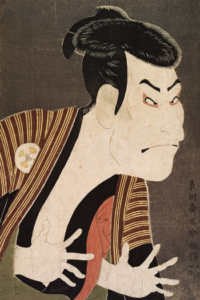Ukiyo-e prints were similar to the modern-day picture postcards, posters and book illustrations.
During the Edo period, the Ukiyo-e spread explosively as entertainment for the general public to enjoy.
At that time, paintings by professional painters in Japan were something that only rich people could enjoy.
However, Ukiyoe can be sold at a very low price of several hundred yen with current money ($2–4). The great cost reduction was achieved by mass production with woodcuts, and it has developed as entertainment for the general public.
We introduce such a Ukiyoe picture this time.
History of Ukiyo-e
It is the Edo period that ukiyoe spread widely to the common people.
The era of war was over, and it was Hishikawa Moronobu who created the trigger for the birth of Ukiyo-e in the stable Edo world.
Although Hishikawa was originally an artist who drew illustrations of books, he gradually became more popular than the contents of books and began to produce single-plate prints.
The meaning of Ukiyo-e
The source of the word “Ukiyo(浮世)” is the hard and difficult world (憂世).
Ukiyo is derived from the thoughts “Since one point ahead is dark, we can clean up everything on the spot. We can enjoy the moon and flowers, sing a song, drink alcohol. We do not bother even if we run out of money, not thinking deeply. Let’s seize the day!”
Ukiyo-e became popular in the late 1800s
Ukiyo-e is widely spread to the common people, but more than three-quarters of the remaining Ukiyo-e are in foreign countries.
Ukiyo-e, which has become so close to us, is no longer treated as a “preserved art picture”, so in Japan, there were few people who would preserve them for many years.
Fortunately, foreigners recognized the values of Ukiyo-e.
During the Edo period, Westerners who saw the ukiyo-e were surprised at their unique color and composition.
Then, in 1867, when a large number of Japanese crafts and ukiyo-e were exhibited at the World Expo in Paris, France.
A great response was received, and Ukiyo-e boom took place.
The wave of Japanese Ukiyo-e boom also spreads among Western painters.
Among them, it was the Impressionists who were particularly affected (e.g., Gogh, Claude Monet, Edgar Degas, Edouard Manet, etc).
5 Famous Ukiyo-e
#1: Yakko Edobe by Otani Oniji 3rd.

The figure of the actor is drawn individually and powerfully.
He has a very short period of about 10 months as an artist and after that, he disappeared somewhere. So his personality and skills of arts are not clearly understood.
#2: Souma-no-Furudairi by Utagawa Kuniyoshi

It is a Ukiyo-e that does not seem like a work drawn about 200 years ago, and we can feel the novelty even if we look at the present.
#3: Mikaeri Bijin (Art of a beautiful woman looking back) by Moronobu Hishikawa

To tell the truth, it is not Ukiyo-e but a painting.
But it is a masterpiece of Hishikawa Yoshinori, the ancestor of ukiyo-e, and often has many opportunities to be introduced as the root of Ukiyo-e.
#4: Nihon Bashi Asa no Kei (The Nihonbashi bridge in the morning) by Utagawa Hiroshige

Fishermen carrying fish were drawn dynamically, and you can feel the liveliness of the Nihonbashi bridge in the morning.
#5 Kanagawa Oki Nami Ura by Katsushika Hokusai

This is a masterpiece of Ukiyo-e and Japanese art, with a bold composition of dynamic waves and Mt. Fuji.
In fact, this Ukiyo-e is drawn based on precise calculations, so that the viewer’s point of view naturally goes to Mt. Fuji.
Let’s Enjoy Ukiyo-e
Ukiyo-e is a world-famous Japanese art.
It is also a work that is drawn with the richness of ideas that is amazing when we look at them.
Please enjoy the arts of Ukiyo-e!









Comment Comment